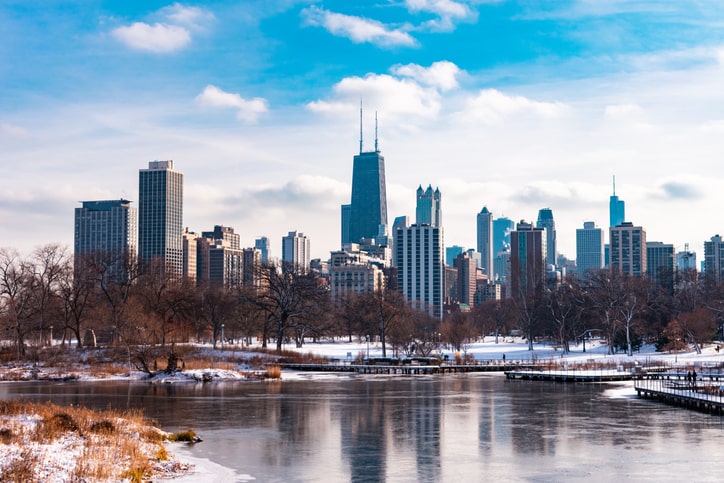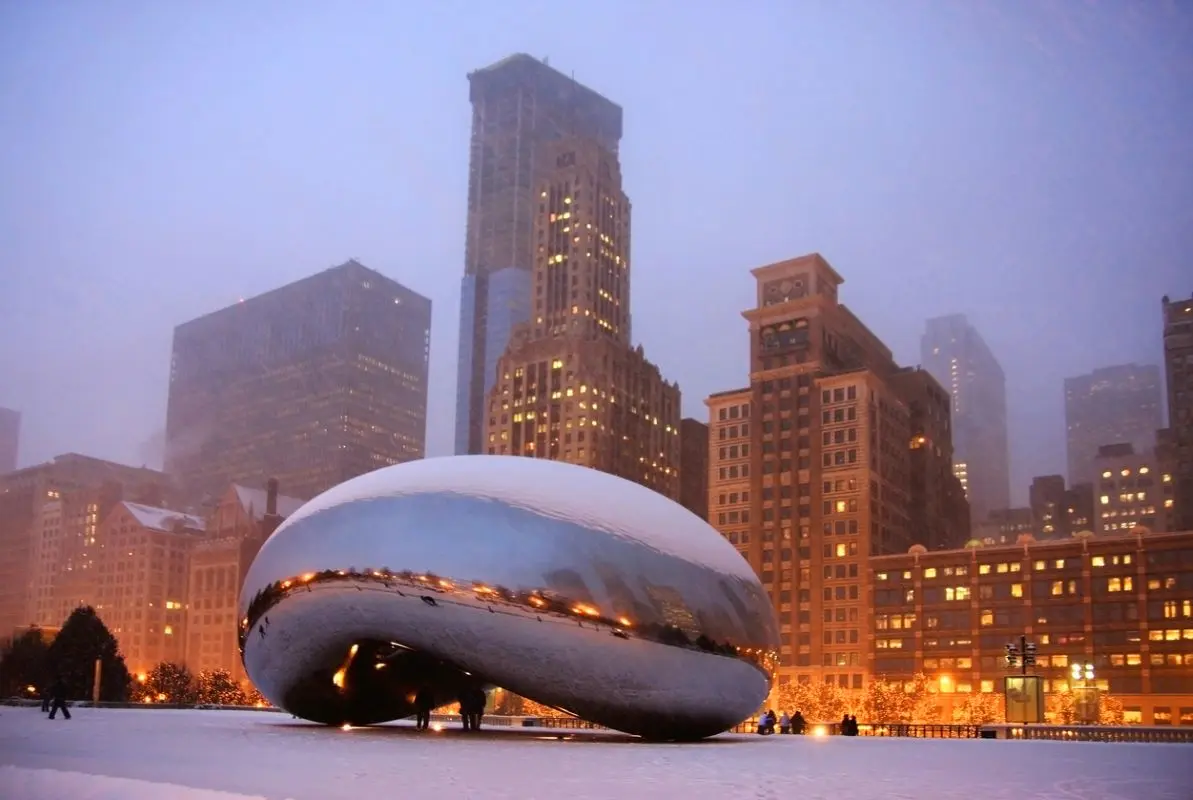
How to Survive Chicago Winters
March 14, 2023 | Moving
Chicago is a vibrant, innovative metropolitan hub in the center of the American Midwest known for its deep-dish pizza, towering skyscrapers, cultural gems, and much more. But when it comes to weather, Chicago is most famous for its cold winters.
Moving to a new city can be overwhelming, especially when relocating to a part of the country with completely different weather patterns from what you’ve known. So if you’re unfamiliar with freezing temperatures and windy days, getting accustomed to Chicago Winters can take a little time and preparation.
When it comes to Chicago winters, we’ve got a few tips to help you out. First, as native Chicagoans, Metro Self Storage has been providing clean, friendly, and affordable storage solutions here in Chicago for 50 years, and we’re celebrating our 50th anniversary in 2023!
Keep reading to learn how to survive winters in Chicago, from what to expect to how to cope and even thrive. Even during the coldest part of the year, there’s a never-ending list of places to go and things worth seeing.
Chicago Weather in the Winter
The good news is that we experience four distinct seasons for those who love summer evenings, spring gardens, winter snow, and fall colors throughout the year. The not-so-good news is the Chicago winter weather can be unpredictable. Even so, you take comfort in knowing that other areas of the country are even more difficult for weather forecasters.
Why can Chicago winters be unpredictable? The answer lies with the vast and beautiful Lake Michigan. The lake is a significant factor in weather patterns in the Windy City due to its thermal mass, which can cause abrupt temperature changes during winter and summer. However, it often contributes to a welcome breeze on hot, humid summer nights.
How Cold Are Chicago Winters?
Chicago winters are infamous for their freezing temperatures, often accompanied by strong winds and heavy snowfall. On average, winter temperatures range from the mid-20s to low 30s (°F), but wind chills can make it feel much colder. January is typically the coldest month, with nighttime temperatures frequently dropping below zero. Snowfall is common from November through March, with the city experiencing around 35 inches of snow each winter. It’s essential to bundle up in layers, as Chicago’s lakefront location often brings unpredictable cold snaps and blizzards.
Stay Active During Winters in Chicago
Staying active during the winter months is important for physical and mental health. A few favorite outdoor winter activities for Chicagoans include ice skating, skiing, sledding, snowshoeing, snow tubing, and snowboarding. In addition, several ski resorts near Chicago cater to beginner skiers and families and more advanced skiers and boarders.
Another way to stay active after moving to Chicago is to learn how to ice skate. You’ll see charming ice rinks pop up all over the city, usually starting in November and ending around March. Skating in Millenium Park, a cherished tradition enjoyed by locals and tourists alike, is where you’ll find two free public skating rinks.
As Christmas approaches, take advantage of a chance to skate at the McCormick Tribune ice rink in Millenium Park, which offers views of the sparkling lights on Chicago’s towering Christmas tree and the downtown skyline.
Other places to skate include Maggie Daley Park Skating Ribbon, Light Up the Lake at Navy Pier, and Winterland at Gallagher Way in Wrigley Field.
Things to Do in Chicago in the Winter
Spending an entire day shopping at the Water Tower Place, an eight-level atrium on Chicago’s Magnificent Mile, is easy. There are over a dozen restaurants and 60 retail stores, including American Girl Place and a Lego store (one of five in the Chicago area!).
Even if you’re not a sports fan, you’re sure to become one once you attend a game at the United Sports Center near the Westside Neighborhood in Chicago. Affectionately called “The Madhouse on Madison” by locals, the United Sports Center is home to the Bulls basketball team and Blackhawks hockey team.
As spring approaches, celebrate St. Patrick’s Day in March when the downtown branch of the Chicago River is dyed bright green, a tradition dating back to 1962. Be prepared to bundle up, though, because it’s usually bitter cold in March, and it could be snowing. Chicago’s equally famous St. Patrick’s Day Parade is also held the same Saturday the river is dyed green.
If you’re living in Chicago on a budget, the Lincoln Park Zoo is always free. So while you’ll want to bundle up for an extended period outdoors, many cold-loving animals, including polar bears, red pandas, snowy owls, and Japanese Snow Monkeys, reside at the Lincoln Park Zoo.
There is no shortage of museums in Chicago, making them a favorite cold-weather destination. You’ll never get tired of arts and culture between the Field Museum, Adler Planetarium, Chicago History Museum, Shedd Aquarium, and the Mexican Museum of Art, to name just a few.
Lesser known but equally fascinating museums include the Museum of Surgical Science, the only one of its kind in the world, the National Veterans Art Museum, and the Museum of Contemporary Art.
After all, who wants to spend a beautiful sunny day indoors when you can visit these destinations during inclement weather?

Driving in Chicago – Learn to Drive in the Snow and Ice
Driving on snow and ice can be scary and dangerous for even the most experienced drivers. You’ll want to prepare your car for winter driving before icy conditions arrive. Go to your car dealership or where you can get your oil changed so a mechanic can walk you through the steps, including adjusting tire pressure and fluid levels and installing new windshield wipers.
Be sure to keep life-saving items in your call all winter long. Chicagoans keep a snow shovel, extra gloves, and hats in their cars, and this list expands for long-distance trips. On most days, make time for shoveling out your car, which will become another part of the morning routine. You’ll want to invest in one or two good-quality snow brushes to remove loose snow from your car windows, roof, and headlamps.
Practice breaking before you get onto busy streets. For example, anti-lock brakes behave differently in icy conditions and will take longer and longer to stop your car. Additionally, enrolling in a defensive driving course will help you gain confidence before getting out on wintry roads.
Thrilling Chicago Views
Get the best views in Chicago at one of two observatories. 360 Chicago, located in the John Hancock Center, offers breathtaking views of the Chicago skyline and the shores of Lake Michigan from the 94th floor. Skydeck Chicago, located in Willis Tower, the tallest building in Chicago, offers views spanning four states from the 103rd-floor observation deck.
The tourist-oriented, City Pass offers admission at a discount to Chicago’s Top Attractions, which include Skydeck Chicago, Shedd Aquarium, and Field Museum, in addition to access to two of the following: Museum of Science and Industry, 360 CHICAGO Observation Deck, or Art Institute of Chicago. The downside for locals is that you have only nine days to visit all five destinations.
Keep in mind every winter is its unique adventure. But wintertime in any city is an excellent time to declutter and donate, and several Chicago charities make the process simple and convenient. If you are experiencing the winter blues in Chicago, check out one of Chicago’s light shows. You’ve probably never experienced anything like these cutting-edge light art installations, and the experience is sure to lighten your mood.
Metro Self Storage is a Chicago name you can trust during your winter move to Chicago. We opened one of the country’s first storage facilities here and have grown to become one of the nation’s most respected storage providers.
Chicago Winter Storage Solutions with Metro
Whether you’re moving to Chicago from across the city or the country, our friendly storage teams know Chicago winters and can help you every step of the way. Warm up your winter move by browsing our Chicago storage units or visiting us online to reserve your household storage unit.



